snow
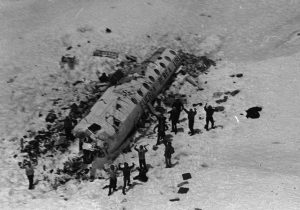 On October 13, 1972 a plane crashed somewhere in the Andes Mountains. That isn’t such an unusual event, but the crash was the last part of this event that was not unusual. Flight 571 was en route from Uruguay to Chili at the time it went down. The Uruguayan Air Force plane was chartered by the Old Christians Club to transport the team from Montevideo, Uruguay to Santiago, Chile. On October 12 the twin-engined Fairchild turboprop left Carrasco International Airport. The plane was carrying 5 crew members and 40 passengers. In addition to club members…friends, family, and others were also on board, having been recruited to help pay the cost of the plane. Because of poor weather in the mountains, they were forced to stay overnight in Mendoza, Argentina, before departing at about 2:18 pm the following day, October 13th. Although Santiago was located to the west of Mendoza, the Fairchild was not built to fly higher than approximately 22,500 feet. Because the Andes mountains were higher than that, the pilots plotted a course south to the Pass of Planchón, where the aircraft could safely clear the Andes mountains. An hour after takeoff, the pilot notified air controllers that he was flying over the pass, and shortly thereafter he radioed that he had reached Curicó, Chile, some 110 miles south of Santiago, and had turned north. However, the pilot had misjudged the location of the aircraft, which was still in the Andes mountains. Unaware of the mistake, the controllers cleared him to begin descending in preparation for landing. Then suddenly, the Chilean control tower was unable to contact the plane.
On October 13, 1972 a plane crashed somewhere in the Andes Mountains. That isn’t such an unusual event, but the crash was the last part of this event that was not unusual. Flight 571 was en route from Uruguay to Chili at the time it went down. The Uruguayan Air Force plane was chartered by the Old Christians Club to transport the team from Montevideo, Uruguay to Santiago, Chile. On October 12 the twin-engined Fairchild turboprop left Carrasco International Airport. The plane was carrying 5 crew members and 40 passengers. In addition to club members…friends, family, and others were also on board, having been recruited to help pay the cost of the plane. Because of poor weather in the mountains, they were forced to stay overnight in Mendoza, Argentina, before departing at about 2:18 pm the following day, October 13th. Although Santiago was located to the west of Mendoza, the Fairchild was not built to fly higher than approximately 22,500 feet. Because the Andes mountains were higher than that, the pilots plotted a course south to the Pass of Planchón, where the aircraft could safely clear the Andes mountains. An hour after takeoff, the pilot notified air controllers that he was flying over the pass, and shortly thereafter he radioed that he had reached Curicó, Chile, some 110 miles south of Santiago, and had turned north. However, the pilot had misjudged the location of the aircraft, which was still in the Andes mountains. Unaware of the mistake, the controllers cleared him to begin descending in preparation for landing. Then suddenly, the Chilean control tower was unable to contact the plane.
The pilot basically found himself caught with high mountains all around him…mountains that he could not climb over. When the plane tried to climb out the wings were clipped by the peaks, and the plane crashed in an unknown location. Because the Chilean control tower thought the plane was much further south, they weren’t even sure where to look. To make matters worse, the white plane was extremely difficult to see against the white snow. Search and rescue efforts from the sky were almost impossible…despite the survivors’ attempts to become noticeable. After 11 days, it was assumed that all of the 45 passengers and crew were dead, so search and rescue efforts ceased. The passengers had access to a radio, and when they heard the news of the search 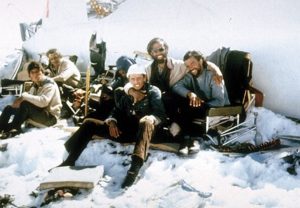 being called off, they were devastated. The crash killed 12 people instantly, leaving 33 survivors to try to stay alive until help could come. A number of the survivors were injured. At an altitude of approximately 11,500 feet, the group faced snow and freezing temperatures. There was no heat, and they only had each other to depend on. While the plane’s fuselage was largely intact, it provided limited protection from the freezing temperatures they faced. Food was scarce…mainly candy bars and wine. Even with rationing, those were gone in about a week. Now the survivors faced the most horrifying decision of their lives. Do they stay alive at all costs, including eating the bodies of the dead for food, or do they simply give up and starve to death? After a heated discussion, the starving survivors resorted to eating the corpses. Their survival instincts had kicked in, even though they knew they might be condemned by the world. Nevertheless, they would probably never forgive themselves anyway, so what the world decided made no real difference. Over the next few weeks six others died, and further disaster struck on October 29, when an avalanche buried the fuselage and filled part of it with snow, causing eight more deaths.
being called off, they were devastated. The crash killed 12 people instantly, leaving 33 survivors to try to stay alive until help could come. A number of the survivors were injured. At an altitude of approximately 11,500 feet, the group faced snow and freezing temperatures. There was no heat, and they only had each other to depend on. While the plane’s fuselage was largely intact, it provided limited protection from the freezing temperatures they faced. Food was scarce…mainly candy bars and wine. Even with rationing, those were gone in about a week. Now the survivors faced the most horrifying decision of their lives. Do they stay alive at all costs, including eating the bodies of the dead for food, or do they simply give up and starve to death? After a heated discussion, the starving survivors resorted to eating the corpses. Their survival instincts had kicked in, even though they knew they might be condemned by the world. Nevertheless, they would probably never forgive themselves anyway, so what the world decided made no real difference. Over the next few weeks six others died, and further disaster struck on October 29, when an avalanche buried the fuselage and filled part of it with snow, causing eight more deaths.
It was decided that someone would have to walk out and tell the officials that they were still alive. On December 12, with just 16 people still alive, three passengers set out for a 10 day journey to find help, though one later returned to the wreckage. After a difficult trek, the other two men finally came across three herdsmen in the village of Los Maitenes, Chile, on December 20. However, the Chileans were on the opposite side of a river, the noise of which made it hard to hear. The herdsmen indicated that they would return the following day. Early the next morning, the Chileans reappeared, and the two groups communicated by writing notes on paper that they then wrapped around a rock and threw across the water. The survivors’ initial note began, “I come from a plane that fell in the mountains.” The Chileans must have heard about the crash, and were most likely stunned to find that there were actually survivors. They hurried to notified authorities, and on December 22 two helicopters were sent to the wreckage. Six survivors were flown to safety, but bad weather delayed the eight others from being rescued until the next day. The 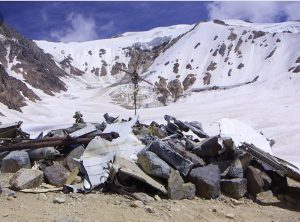 rescue was called the Miracle of the Andes. In the resulting media frenzy, the survivors revealed that they had been forced to commit cannibalism. Many people were outraged until one of the survivors claimed that they had been inspired by the Last Supper, in which Jesus gave his disciples bread and wine that he stated were his body and his blood. This helped soften public opinion, and the church later absolved the men. After watching the movie based on this event, I wondered how any of the rest of us would have handled that situation. We should never be too quick to judge people in such a situation, because we might find that given the same circumstances, we might do the exact same thing.
rescue was called the Miracle of the Andes. In the resulting media frenzy, the survivors revealed that they had been forced to commit cannibalism. Many people were outraged until one of the survivors claimed that they had been inspired by the Last Supper, in which Jesus gave his disciples bread and wine that he stated were his body and his blood. This helped soften public opinion, and the church later absolved the men. After watching the movie based on this event, I wondered how any of the rest of us would have handled that situation. We should never be too quick to judge people in such a situation, because we might find that given the same circumstances, we might do the exact same thing.

 After serving in the Navy for six years, my nephew, Allen Beach decided that it was time to move on to get the education that he wanted, which is hospital administration. He began his Navy career planning to become a pilot, but an injury forced him out of the program early on. He then decided to become a Corpsman, and found that he had a knack for that. His first duty station was in Bethesda, Maryland at Walter Reed Rational Military Medical Center, a term of service he was very proud of. While there, he was one of the EMTs who took care of the medical needs of the first family.
After serving in the Navy for six years, my nephew, Allen Beach decided that it was time to move on to get the education that he wanted, which is hospital administration. He began his Navy career planning to become a pilot, but an injury forced him out of the program early on. He then decided to become a Corpsman, and found that he had a knack for that. His first duty station was in Bethesda, Maryland at Walter Reed Rational Military Medical Center, a term of service he was very proud of. While there, he was one of the EMTs who took care of the medical needs of the first family.
After his term at Walter Reed Medical Center, Allen was stationed in Japan, which is where he met his future wife, Gabby, who was also a Corpsman stationed at the same base. Needless to say, Allen was very happy with his time in Japan, and meeting the love of his life. After that, Allen left the Navy, and for Gabby’s final year, they were stationed back at Walter Reed Medical Center. Now that both of them are out of the Navy, they have decided to move to Casper, Wyoming so that Gabby can continue her education too. Casper College has an excellent nursing program, and that is her chosen field. So, upon their release from the Navy, the headed west.
At this point, Allen and Gabby are living in an apartment on his mom and step-dad’s land outside of town. I’m sure that is quite a culture shock to them after the hustle and bustle of the Washington DC area. In addition,  they are getting used to the winters in Wyoming. Not that they never got snow in Japan or in Washington DC, but I don’t think they had the winds like we have here. One nice thing about the move was the ability to be closer to family. Allen and Gabby were able to spend Christmas week in Rawlins with the family there, and they all had a great time. They have really taken to country living, and other than the severe cold causing their pipes to freeze, life is good. Allen is still looking for a job, so once he gets a job they will be set, as his classes are online. We are very proud of all of his s accomplishments, and we know that the future will be bright for both of them. Today is Allen’s birthday. Happy birthday Allen!! Have a great day!! We love you!!
they are getting used to the winters in Wyoming. Not that they never got snow in Japan or in Washington DC, but I don’t think they had the winds like we have here. One nice thing about the move was the ability to be closer to family. Allen and Gabby were able to spend Christmas week in Rawlins with the family there, and they all had a great time. They have really taken to country living, and other than the severe cold causing their pipes to freeze, life is good. Allen is still looking for a job, so once he gets a job they will be set, as his classes are online. We are very proud of all of his s accomplishments, and we know that the future will be bright for both of them. Today is Allen’s birthday. Happy birthday Allen!! Have a great day!! We love you!!
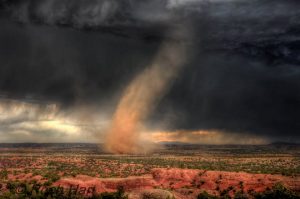 Weather has always been a subject of interest to people, even if we still don’t completely have a full grasp of it, not even after all these years and all our technology. The main difference I see now is that we hear about weather all the time. It’s on television, the radio, and even our phones. There are warnings for everything…thunder storms, tornadoes, snow storms, flash floods, and hurricanes. Nevertheless, all the meteorologists can truly do is predict a weather event. It may or may not materialize.
Weather has always been a subject of interest to people, even if we still don’t completely have a full grasp of it, not even after all these years and all our technology. The main difference I see now is that we hear about weather all the time. It’s on television, the radio, and even our phones. There are warnings for everything…thunder storms, tornadoes, snow storms, flash floods, and hurricanes. Nevertheless, all the meteorologists can truly do is predict a weather event. It may or may not materialize.
Now, flash back to, oh say 1680 or even to 1521. Other than looking at the sky, how did the people predict the weather? Yes the sky can be a great predictor of coming storms, but unless you knew something about weather 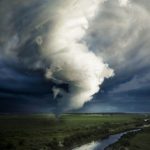 patterns, you would be unlikely to have any idea that something like a tornado, flood, or hurricane were coming. Especially in 1680 or 1521. Those dates are rather important in the world of weather. In August of 1521, a meteorological phenomenon occurred in the Basin of Mexico. There were no cameras back them, no cell phones or computers to record the event. The only known description appears in Book XII of the Florentine Codex, which is an account of the Spanish conquest of Mexico written in Nahuatl in the mid-sixteenth century. The account states that just before the fall of Mexico-Tenochtitlan a heavy storm which included a whirlwind struck the basin. The whirlwind hovered for a while above Tlatelolco, Tenochtitlan’s twin city. Then it moved to the lake where it disappeared.
patterns, you would be unlikely to have any idea that something like a tornado, flood, or hurricane were coming. Especially in 1680 or 1521. Those dates are rather important in the world of weather. In August of 1521, a meteorological phenomenon occurred in the Basin of Mexico. There were no cameras back them, no cell phones or computers to record the event. The only known description appears in Book XII of the Florentine Codex, which is an account of the Spanish conquest of Mexico written in Nahuatl in the mid-sixteenth century. The account states that just before the fall of Mexico-Tenochtitlan a heavy storm which included a whirlwind struck the basin. The whirlwind hovered for a while above Tlatelolco, Tenochtitlan’s twin city. Then it moved to the lake where it disappeared.
When the experts of today look at the account of the phenomenon in the context of the Nahua culture, and 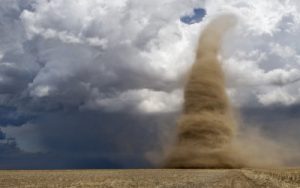 comparing it with European descriptions of tornados and waterspouts, they can determine that the phenomenon was indeed a tornado. Their conclusion is further supported by eighteenth and nineteenth century pictorial and written evidence showing that tornadoes do occur in the territory now occupied by Mexico City. Since the tornado of Tlatelolco predates the Cambridge, Massachusetts, tornado of July 8, 1680, which had been thought to be the first recorded tornado in the Americas, the Tlatelolco tornado actually represents the earliest documented tornado in the Americas. Either way, since people didn’t really have much information to go on back then, I’m sure they first said some version of “What is that?!!?” At least, I know I would have.
comparing it with European descriptions of tornados and waterspouts, they can determine that the phenomenon was indeed a tornado. Their conclusion is further supported by eighteenth and nineteenth century pictorial and written evidence showing that tornadoes do occur in the territory now occupied by Mexico City. Since the tornado of Tlatelolco predates the Cambridge, Massachusetts, tornado of July 8, 1680, which had been thought to be the first recorded tornado in the Americas, the Tlatelolco tornado actually represents the earliest documented tornado in the Americas. Either way, since people didn’t really have much information to go on back then, I’m sure they first said some version of “What is that?!!?” At least, I know I would have.
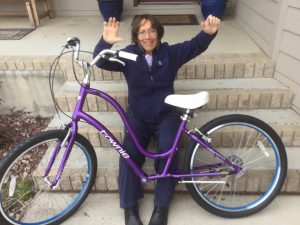
 For most of her life, my sister-in-law, Brenda Schulenberg struggled with her weight. Even as a child, Brenda was heavy. She will tell you that her weight prevented her from doing many of the things that most children took for granted, such as riding a bicycle. She might have been able to do it to a degree, but not for very long or very far. As she grew into adulthood, her weight became such a problem that she couldn’t even think of riding a bicycle. Then one day, her health failed due to her weight. She knew that she had to make a change. That day was October 18, 2013…just 5½ months after her dad, Walt Schulenberg passed away. Brenda became a health nut. She learned to eat right, and she walked…slowly and with a walker at first, and later on her own. She walked further and further…often reaching 10 miles a day. The weight came off, and she felt much better. Still, one thing eluded her…riding a bicycle. Finally, the day arrived when Brenda found out that she could ride a bicycle…as long as the peddles were off, and she could reach the ground. It’s called strider riding. It is a bicycle, but the rider basically runs the bicycle down the trail, instead of riding it…and Brenda could do that.
For most of her life, my sister-in-law, Brenda Schulenberg struggled with her weight. Even as a child, Brenda was heavy. She will tell you that her weight prevented her from doing many of the things that most children took for granted, such as riding a bicycle. She might have been able to do it to a degree, but not for very long or very far. As she grew into adulthood, her weight became such a problem that she couldn’t even think of riding a bicycle. Then one day, her health failed due to her weight. She knew that she had to make a change. That day was October 18, 2013…just 5½ months after her dad, Walt Schulenberg passed away. Brenda became a health nut. She learned to eat right, and she walked…slowly and with a walker at first, and later on her own. She walked further and further…often reaching 10 miles a day. The weight came off, and she felt much better. Still, one thing eluded her…riding a bicycle. Finally, the day arrived when Brenda found out that she could ride a bicycle…as long as the peddles were off, and she could reach the ground. It’s called strider riding. It is a bicycle, but the rider basically runs the bicycle down the trail, instead of riding it…and Brenda could do that. 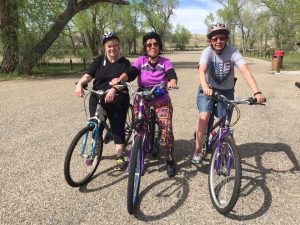
After riding strider style for a time, Brenda was finally able to ride a bicycle in the normal way. She put the peddles back on her purple bicycle and off she went. Brenda became just like the postal service…”Neither snow nor rain nor heat nor gloom of night stays these couriers from the swift completion of their appointed rounds.” Ok, Brenda didn’t have appointed rounds…exactly, but she had set herself a goal of riding her bicycle every month of the year. Now, that is not an easy task, especially in the state of Wyoming, where winters can be brutal. Nevertheless, just like the postal worker, neither rain, nor sleet, nor snow, nor gloom of the very early morning will keep Brenda from riding her bicycle. She is determined to ride it, and make up for all the years that she couldn’t even ride a bicycle in the summertime, much less in the winter.
She’s a brave woman, especially when she goes out in the middle of a snow story, and pretty much turns into a 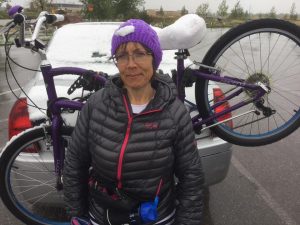
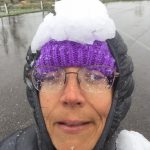 snow woman. She reminds me of the Campbell’s Soup commercial where the little boy is so covered with snow that only a hot bowl of soup will melt away all the snow. Maybe she’s not that bad, but she’s close. Brenda, we are proud of your determination, but I do have to wonder if the people driving by the snow woman on wheels have to rubs their eyes to make sure they are seeing what their eyes are telling them they are seeing. Today is Brenda’s birthday. Happy birthday Brenda!! Have a great day!! We love you!!
snow woman. She reminds me of the Campbell’s Soup commercial where the little boy is so covered with snow that only a hot bowl of soup will melt away all the snow. Maybe she’s not that bad, but she’s close. Brenda, we are proud of your determination, but I do have to wonder if the people driving by the snow woman on wheels have to rubs their eyes to make sure they are seeing what their eyes are telling them they are seeing. Today is Brenda’s birthday. Happy birthday Brenda!! Have a great day!! We love you!!

 My son-in-law, Travis Royce is without a doubt, the most social person in our family. Travis can talk to anyone. There isn’t a shy bone in his body. I think that is one thing that made him such a great DJ when he and my daughter, Amy lived here in Casper. Travis was born in San Diego, and spent a number of years in Puyallup, Washington as a child. He loved it there, and loves the coastal areas in general, so after their children graduated from high school, they made the move to the Seattle area, and now to the Bellingham area. They truly love the area, and I can understand that, because it is quite beautiful there. I don’t know if would love the rain, but they seem to, so it’s all good.
My son-in-law, Travis Royce is without a doubt, the most social person in our family. Travis can talk to anyone. There isn’t a shy bone in his body. I think that is one thing that made him such a great DJ when he and my daughter, Amy lived here in Casper. Travis was born in San Diego, and spent a number of years in Puyallup, Washington as a child. He loved it there, and loves the coastal areas in general, so after their children graduated from high school, they made the move to the Seattle area, and now to the Bellingham area. They truly love the area, and I can understand that, because it is quite beautiful there. I don’t know if would love the rain, but they seem to, so it’s all good.
Travis can make friends wherever he goes, and he loves to entertain…especially with a barbeque. He loves to go all out with the feast he puts on too. He might cook steaks, lobster, or jalapeno poppers…or just burgers. No matter what’s cooking Travis is a good cook, and he is a great host. As I said, he loves to entertain, and he is quick witted, so there is never a dull moment. When Travis is around, there is always a joke going on. Even when my daughter, Amy and Travis aren’t entertaining, they love to sit out in their back yard with a fire going, just enjoying the peace and quiet. Their home is out in the country…or at the edge of town anyway, so it is quiet a quiet neighborhood.
Now you might think that with their love of the country life, quiet would be the order of the day, but that is not always the case. As summer approaches, both Amy and Travis look forward to getting out their motorcycle 
 and cruising the area. With all of the water destinations in their vicinity, they have a lot of pretty drives that they can take. Travis is definitely not a snow lover, so Western Washington is pretty ideal. He wants as many warm months as possible. I can relate to that, but I don’t know that Washington is the ideal place. Still, as Amy says, they don’t like the extreme heat either, so there you have it. All I care about is that Travis loves my girl, and he does. Today is Travis’ birthday. Happy birthday Travis!! Have a great day!! We love you!!
and cruising the area. With all of the water destinations in their vicinity, they have a lot of pretty drives that they can take. Travis is definitely not a snow lover, so Western Washington is pretty ideal. He wants as many warm months as possible. I can relate to that, but I don’t know that Washington is the ideal place. Still, as Amy says, they don’t like the extreme heat either, so there you have it. All I care about is that Travis loves my girl, and he does. Today is Travis’ birthday. Happy birthday Travis!! Have a great day!! We love you!!

 My second cousin twice removed, Hazel Grace Pallas, daughter of Angel and Brian Pallas, is quite a character. I have only met Hazel and her family via Facebook, but her mom and her aunt, Elizabeth Nordquist, have posted a lot of pictures of the kids, and along with the stories they provide, I feel like I’ve known their kids forever. As I said, Hazel is a character, but she is also a Girly Girl, and could even be classed as a Diva, but that isn’t surprising, because she spends a lot of time with her cousins, Addilayde and Meadow Nordquist, daughters of Elizabeth and Aron Nordquist, and they can definitely be Divas.
My second cousin twice removed, Hazel Grace Pallas, daughter of Angel and Brian Pallas, is quite a character. I have only met Hazel and her family via Facebook, but her mom and her aunt, Elizabeth Nordquist, have posted a lot of pictures of the kids, and along with the stories they provide, I feel like I’ve known their kids forever. As I said, Hazel is a character, but she is also a Girly Girl, and could even be classed as a Diva, but that isn’t surprising, because she spends a lot of time with her cousins, Addilayde and Meadow Nordquist, daughters of Elizabeth and Aron Nordquist, and they can definitely be Divas.
While these girls can be girly and artsy, they also love to play, and they have a great time together; as well as with Hazel’s little sister, Tenley; and their cousins, Hosea and Canaan Oltman, sons of Grace and Tzaddik 
 Oltman. It’s so much fun to look at the great pictures of these close families of cousins. The moms take pictures often, especially Elizabeth, who is a photographer in her own right, so I have watched these kids grow up almost all of their lives.
Oltman. It’s so much fun to look at the great pictures of these close families of cousins. The moms take pictures often, especially Elizabeth, who is a photographer in her own right, so I have watched these kids grow up almost all of their lives.
Addi and Meadow, being the oldest ones, inspire all the fun around there. They play with all the kids, and really enjoy having their cousins come over. The other day, the three older girls, Addi, Meadow, and little Hazel were out in the back yard, playing in the snow. For Hazel, who is 2½ years old, I think this is still a very new experience. Nevertheless, it is one she very much enjoyed. The girls got out anything the could slide on, and they had a wonderful time slipping and sliding on the snow. When Hazel told her mom about all she did that afternoon, she simple 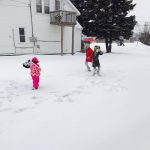
 summed it up as, “Swimming in the snow, Mom!” When I read that comment, I just laughed and laughed. It was perfect. To have that childhood enjoyment of the snow…untainted by the experiences of driving in the snow, and all the stress that comes with it…seemed like a dream world to me. As I was driving to work this morning, with little Hazel on my mind, I noticed that as I drove down the alley from my backyard garage, over the freshly fallen snow, it felt like I was almost floating along. Hazel’s words came to my mind. “Swimming in the snow, Mom!” I think I know how Hazel felt.
summed it up as, “Swimming in the snow, Mom!” When I read that comment, I just laughed and laughed. It was perfect. To have that childhood enjoyment of the snow…untainted by the experiences of driving in the snow, and all the stress that comes with it…seemed like a dream world to me. As I was driving to work this morning, with little Hazel on my mind, I noticed that as I drove down the alley from my backyard garage, over the freshly fallen snow, it felt like I was almost floating along. Hazel’s words came to my mind. “Swimming in the snow, Mom!” I think I know how Hazel felt.
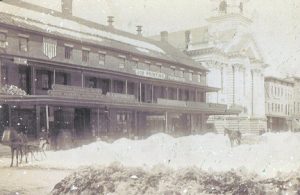 With all of the extreme weather shows, warnings, and education we have access to these days, one would think that blizzard related deaths would quickly become a thing of the past, but it never seems to go that way exactly. Nevertheless, it used to be much worse. In bygone years, the warnings we have today simply didn’t exist, and blizzards were very much feared by the people, and with good reason too. The storms would come up, seemingly without notice, and I suppose that was how it was. People couldn’t turn on their radio, television, computers, or smart phones, and get the weather forecast. They could look at the sky and feel the temperature changing, and maybe guess at what was coming, but if they were wrong, it could be deadly. Such was the case on January 12, 1888, when a blizzard blew into the Northwest Plains region of the United States with little or no warning. Some people said that the temperature dropped 100° in just 24 hours. A lot maybe, but I’ve seen temperature changes of more than 60°, so it’s possible.
With all of the extreme weather shows, warnings, and education we have access to these days, one would think that blizzard related deaths would quickly become a thing of the past, but it never seems to go that way exactly. Nevertheless, it used to be much worse. In bygone years, the warnings we have today simply didn’t exist, and blizzards were very much feared by the people, and with good reason too. The storms would come up, seemingly without notice, and I suppose that was how it was. People couldn’t turn on their radio, television, computers, or smart phones, and get the weather forecast. They could look at the sky and feel the temperature changing, and maybe guess at what was coming, but if they were wrong, it could be deadly. Such was the case on January 12, 1888, when a blizzard blew into the Northwest Plains region of the United States with little or no warning. Some people said that the temperature dropped 100° in just 24 hours. A lot maybe, but I’ve seen temperature changes of more than 60°, so it’s possible.
It was a Thursday afternoon and the weather had been unseasonably warm the previous day from Montana, east to the Dakotas, and south to Texas. Within a matter of hours, the Artic front blew in, plunging the temperature to 40° below zero in much of North Dakota. The freezing temperatures were joined by high winds and heavy snow. It was lethal combination that created a blinding blizzard, just when the children were on their 
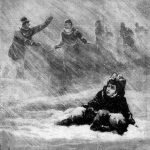
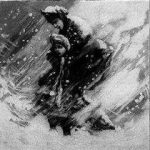 way home from school. The storm, coupled with the time of day, set the stage for a disaster, and unfortunately it would take the lives of 235 people…mostly children making their way home from school in rural areas and adults working on large farms. Both of these groups of people were taken by surprise, and were unable to find their way to their destinations.
way home from school. The storm, coupled with the time of day, set the stage for a disaster, and unfortunately it would take the lives of 235 people…mostly children making their way home from school in rural areas and adults working on large farms. Both of these groups of people were taken by surprise, and were unable to find their way to their destinations.
Some areas decided to err on the side of caution, and that resulted in lives saved. Schoolteacher, Seymour Dopp in Pawnee City, Nebraska, kept his 17 students at school when the storm began at 2 pm. They stayed overnight, burning stockpiled wood to keep warm. The next day, parents made their way over five foot snow drifts to rescue their children. I’m sure they were wondering if they would ever see their children again, because they couldn’t call to check on them, after all. Some areas ha drifts over ten feet too. In Great Plains, 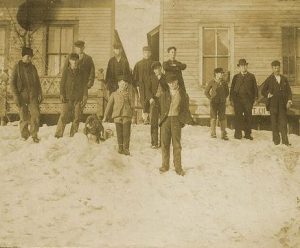 South Dakota, two men rescued the children in a schoolhouse by tying a rope from the school to the nearest shelter to lead them to safety. Minnie Freeman, a Nebraska teacher, successfully led her children to shelter after the storm tore the roof off of her one room schoolhouse. Sadly, not all efforts to save the children were successful. Teacher Loie Royce tried to lead three children to the safety of her home, which was less than 90 yards from their school in Plainfield, Nebraska. They all became lost. The children died of hypothermia, and Royce lost her feet to frostbite. The January 12th storm was dubbed the Schoolchildren’s Blizzard, because most of the 235 victims were children. It is considered one of the worst blizzards in the history of the area, to this day.
South Dakota, two men rescued the children in a schoolhouse by tying a rope from the school to the nearest shelter to lead them to safety. Minnie Freeman, a Nebraska teacher, successfully led her children to shelter after the storm tore the roof off of her one room schoolhouse. Sadly, not all efforts to save the children were successful. Teacher Loie Royce tried to lead three children to the safety of her home, which was less than 90 yards from their school in Plainfield, Nebraska. They all became lost. The children died of hypothermia, and Royce lost her feet to frostbite. The January 12th storm was dubbed the Schoolchildren’s Blizzard, because most of the 235 victims were children. It is considered one of the worst blizzards in the history of the area, to this day.
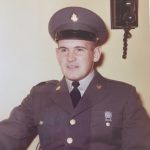
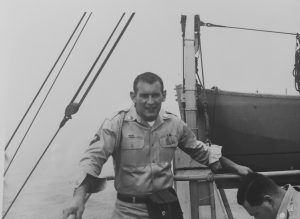 When most people think of Hawaii, they think of a tropical paradise, but for my husband, Bob’s uncle, Butch Schulenberg nothing could be further from the truth…at least not during his days in the service. When we think of Hawaii, snow does not come to mind, but in reality, “It snows here every year, but only at the very summits of our 3 tallest volcanoes (Mauna Loa, Mauna Kea and Haleakala),” says Ken Rubin, geology and geophysics professor at the University of Hawaii. “The snow level almost never gets below 9,000 feet in Hawaii during the winter, but since these mountains are taller than 13,000 feet, 13,000 feet, and 10,000 feet, respectively, they get dusted with snow a few times a year. It rarely stays on the ground for more than a few days though.”
When most people think of Hawaii, they think of a tropical paradise, but for my husband, Bob’s uncle, Butch Schulenberg nothing could be further from the truth…at least not during his days in the service. When we think of Hawaii, snow does not come to mind, but in reality, “It snows here every year, but only at the very summits of our 3 tallest volcanoes (Mauna Loa, Mauna Kea and Haleakala),” says Ken Rubin, geology and geophysics professor at the University of Hawaii. “The snow level almost never gets below 9,000 feet in Hawaii during the winter, but since these mountains are taller than 13,000 feet, 13,000 feet, and 10,000 feet, respectively, they get dusted with snow a few times a year. It rarely stays on the ground for more than a few days though.”
I had no idea, as I’m sure many of you could also say. I don’t know if Butch knew what he was getting into when he and the officer he was driving for, went to one of those areas where there was not only snow, but it was cold…really cold. In fact, the only way that Butch could even begin to stay warm was to bundle up in his sleeping bag. He probably would have tied it all the way over his head, if he could breathe that way. It was a complete shock to his system, as it would have been to mine. Being stationed in Hawaii would be the dream assignment, and here Butch was…in the snow. In fact, I can just hear him telling his parents, “It’s freezing here!!” The thought is almost laughable, or would have been if it weren’t so cold.
Butch told my husband, Bob and me several stories about his driving days in the service, when we were there for a visit about a month ago. It was interesting to listen to the details that a driver would have known about 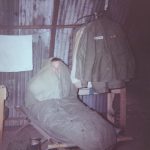
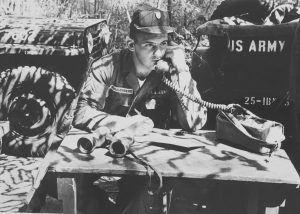 the situations that the company would have been in…and probably a lot of responsibility too. Much of the details of the movements of the company and the battles they engaged in, were classified, and to say anything at the time could have put people in danger or get them killed. A good driver would have known when to talk and when to keep quiet. Butch was a good driver, and well respected. I am proud of his service. Thank you Butch. Today is Butch’s birthday. Happy birthday Butch!! Have a great day!! We love you!!
the situations that the company would have been in…and probably a lot of responsibility too. Much of the details of the movements of the company and the battles they engaged in, were classified, and to say anything at the time could have put people in danger or get them killed. A good driver would have known when to talk and when to keep quiet. Butch was a good driver, and well respected. I am proud of his service. Thank you Butch. Today is Butch’s birthday. Happy birthday Butch!! Have a great day!! We love you!!
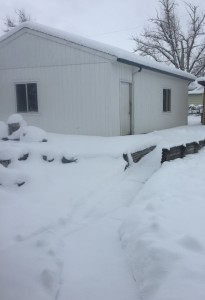 There is an old saying, “If March comes in like a lion, it will go out like a lamb.” If that’s the case, then one must assume that the opposite is also true. And in the case of March, 2016…the opposite would definitely be the case. Bob and I were married on March first, and so we go to Thermopolis around that time to celebrate our anniversary. This year was absolutely beautiful!! It was warm with no snow, and our quiet little walks were just lovely. The groundhog had predicted an early Spring this year…and unusual prediction for him, so I was feeling very optimistic about the remainder of the Winter…or the lack thereof. Now it’s not that I’m superstitious, and I don’t believe that these predictions are superstition anyway, but rather God’s way of showing us little signs of His plans for the future. He tells the animals things that humans just don’t hear, like telling the geese when to fly south or to head north. We humans have somehow become so scientific that we fail to listen to the signs from God.
There is an old saying, “If March comes in like a lion, it will go out like a lamb.” If that’s the case, then one must assume that the opposite is also true. And in the case of March, 2016…the opposite would definitely be the case. Bob and I were married on March first, and so we go to Thermopolis around that time to celebrate our anniversary. This year was absolutely beautiful!! It was warm with no snow, and our quiet little walks were just lovely. The groundhog had predicted an early Spring this year…and unusual prediction for him, so I was feeling very optimistic about the remainder of the Winter…or the lack thereof. Now it’s not that I’m superstitious, and I don’t believe that these predictions are superstition anyway, but rather God’s way of showing us little signs of His plans for the future. He tells the animals things that humans just don’t hear, like telling the geese when to fly south or to head north. We humans have somehow become so scientific that we fail to listen to the signs from God.
Of course, the scientists would say that they are able to predict the weather too, and perhaps they do listen to the signs of God, whether they admit that is what they are doing or not. Still, I find it odd that things like the groundhog not seeing his shadow on February 2nd, or the way March makes it’s annual entrance, can have such an impact of the weather over the next month or so, but they do nevertheless. One thing that many of us have come to look for is the time when the geese fly south. If they head out early, we have a pretty good idea that Winter will soon follow, but if the stay around into late fall, things could be very different for the Winter. They simply have been told that there is no hurry to leave. It is maybe the one sign from God that we humans have noticed over the years.
Be that as it may, we have arrived at the end of March in Wyoming. Enter Winter Storm Troy!! This Winter has been a relatively easy one, even though, the snow that fell in mid-December, didn’t leave the streets until mid-February. Nevertheless, I am pretty much over Winter after the first snow of the season, so I was looking forward to an early Spring. Now, with the end of March upon us, it decides to follow the old saying, and go out 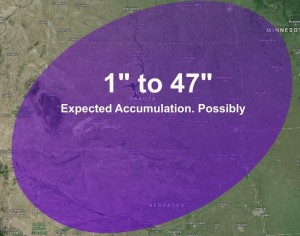 like a lion…since it came in like a lamb. That said, we are sitting here in Wyoming with about sixteen inches of snow on the ground, many businesses closed, and schools that would be…were it not for Spring Break. This storm is not supposed to hang around very long, but those unfortunate people in its path could get anywhere from 1″ to 47″ of the white stuff. I certainly hope we are not on the 47″ end of that scale. The snow is expected to continue through tonight and finally heading out around 6pm tomorrow. After that, look out, because when the temperatures heat up to the low fifties by Sunday, all this snow is going to melt, and become…a whole lot of water. I guess that is the April Fools Day joke in all of this weather prediction process.
like a lion…since it came in like a lamb. That said, we are sitting here in Wyoming with about sixteen inches of snow on the ground, many businesses closed, and schools that would be…were it not for Spring Break. This storm is not supposed to hang around very long, but those unfortunate people in its path could get anywhere from 1″ to 47″ of the white stuff. I certainly hope we are not on the 47″ end of that scale. The snow is expected to continue through tonight and finally heading out around 6pm tomorrow. After that, look out, because when the temperatures heat up to the low fifties by Sunday, all this snow is going to melt, and become…a whole lot of water. I guess that is the April Fools Day joke in all of this weather prediction process.
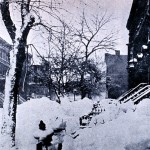 As we sit here, with an early Spring upon us, I find it an odd thing to think about another year that had been rather balmy too. The year was 1888, and things were about to get serious along the northern East Coast. The day began with rain, but as the storm really came at around midnight, the rain turned to snow, and the area began to become a nightmare right before the very eyes of the people in the area. Snowfalls of between 20 to 60 inches were seen in parts of New Jersey, New York, Massachusetts, and Connecticut. The winds howled…sustained winds of more than 45 miles per hour producing snowdrifts in excess of 50 feet. The area railroads were shut down and people were confined to their houses for up to a week. The difficult thing here is that people didn’t have some of the weather predictors that we have these days, so many of them had no idea what was coming their way, and so had far k=less time to prepare for it.
As we sit here, with an early Spring upon us, I find it an odd thing to think about another year that had been rather balmy too. The year was 1888, and things were about to get serious along the northern East Coast. The day began with rain, but as the storm really came at around midnight, the rain turned to snow, and the area began to become a nightmare right before the very eyes of the people in the area. Snowfalls of between 20 to 60 inches were seen in parts of New Jersey, New York, Massachusetts, and Connecticut. The winds howled…sustained winds of more than 45 miles per hour producing snowdrifts in excess of 50 feet. The area railroads were shut down and people were confined to their houses for up to a week. The difficult thing here is that people didn’t have some of the weather predictors that we have these days, so many of them had no idea what was coming their way, and so had far k=less time to prepare for it.
Areas of northern Vermont received from 20 inches to 30 inches in this storm, with drifts reported from 30 to 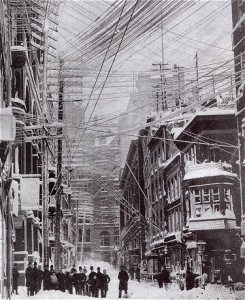 40 feet over the tops of houses from New York to New England. There were also reports of drifts covering 3 story houses. The highest drift…52 feet was recorded in Gravesend, New York. A total of 58 inches of snow fell in Saratoga Springs, New York; 48 inches in Albany, New York; 45 inches of snow in New Haven, Connecticut; and 22 inches of snow in New York City. With the snow came severe winds, with gusts up to 80 miles per hour, although the highest official report in New York City was 40 miles per hour, with a 54 miles per hour gust reported at Block Island. Central Park Observatory, in New York City, reported a low temperature of 6 °F, and a high temperature of 9 °F on March 13…the coldest ever for March. These days Winter Storms have names, but they didn’t then. Nevertheless, the storm was named the Great White Hurricane. It paralyzed the East Coast from the Chesapeake Bay to Maine, as well as the Atlantic provinces of Canada. The Telegraph was disabled because of all the downed lines, isolating Montreal and most of the large northeastern United States cities from Washington DC to Boston for days. Following the storm, New York began placing its telegraph and telephone lines underground to prevent destruction. From Chesapeake Bay through the New England area, more than 200 ships were either grounded or wrecked, killing at least 100 seamen.
40 feet over the tops of houses from New York to New England. There were also reports of drifts covering 3 story houses. The highest drift…52 feet was recorded in Gravesend, New York. A total of 58 inches of snow fell in Saratoga Springs, New York; 48 inches in Albany, New York; 45 inches of snow in New Haven, Connecticut; and 22 inches of snow in New York City. With the snow came severe winds, with gusts up to 80 miles per hour, although the highest official report in New York City was 40 miles per hour, with a 54 miles per hour gust reported at Block Island. Central Park Observatory, in New York City, reported a low temperature of 6 °F, and a high temperature of 9 °F on March 13…the coldest ever for March. These days Winter Storms have names, but they didn’t then. Nevertheless, the storm was named the Great White Hurricane. It paralyzed the East Coast from the Chesapeake Bay to Maine, as well as the Atlantic provinces of Canada. The Telegraph was disabled because of all the downed lines, isolating Montreal and most of the large northeastern United States cities from Washington DC to Boston for days. Following the storm, New York began placing its telegraph and telephone lines underground to prevent destruction. From Chesapeake Bay through the New England area, more than 200 ships were either grounded or wrecked, killing at least 100 seamen.
In New York, all transportation was at a standstill for days, and drifts across the New York–New Haven rail line at Westport, Connecticut took eight days to clear. Partly because of the transportation gridlock, it was decided that they needed a better system, and the first underground subway system in the United States, opened nine years later in 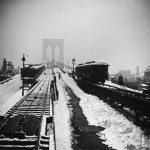 Boston. The New York Stock Exchange was closed for two days…something that almost never happens. Firefighters were unable to get to the fires, and property loss just from the fires was estimated at $25 million. Severe flooding occurred after the storm due to melting snow, especially in the Brooklyn area, which was more susceptible to serious flooding. Efforts were made to push the snow into the Atlantic Ocean. More than 400 people died from the storm and the cold that came with it, including 200 in New York City alone. Among them was former United States Senator Roscoe Conkling. The blizzard also resulted in the founding of the Christman Bird and Wildlife Sanctuary located near Delanson, Schenectady County, New York, which was listed on the National Register of Historic Places in 1970.
Boston. The New York Stock Exchange was closed for two days…something that almost never happens. Firefighters were unable to get to the fires, and property loss just from the fires was estimated at $25 million. Severe flooding occurred after the storm due to melting snow, especially in the Brooklyn area, which was more susceptible to serious flooding. Efforts were made to push the snow into the Atlantic Ocean. More than 400 people died from the storm and the cold that came with it, including 200 in New York City alone. Among them was former United States Senator Roscoe Conkling. The blizzard also resulted in the founding of the Christman Bird and Wildlife Sanctuary located near Delanson, Schenectady County, New York, which was listed on the National Register of Historic Places in 1970.

